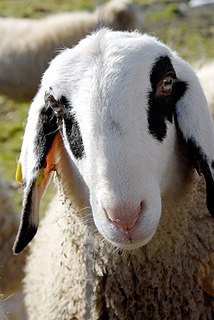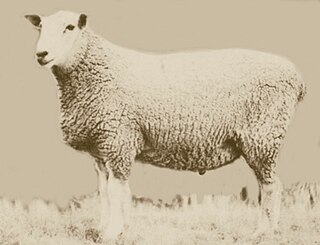Related Research Articles

A goatherd or goatherder is a person who herds goats as a vocational activity. It is similar to a shepherd who herds sheep. Goatherds are most commonly found in regions where goat populations are significant; for instance, in Africa and South Asia. Goats are typically bred as dairy or meat animals, with some breeds being shorn for wool. The top six goat industry groups in the United States include: meat, dairy, fiber or hair, 4-H, industrial, and biotech.

The Boer goat is a breed of goat that was developed in South Africa in the early 1900s and is a popular breed for meat production. Their name is derived from the Afrikaans (Dutch) word boer, meaning farmer.

The Nigerian Dwarf is an American breed of dwarf goat. Like the American Pygmy Goat, it derives from the West African Dwarf group of breeds of West Africa.

A cashmere goat is a type of goat that produces cashmere wool, the goat's fine, soft, downy, winter undercoat, in commercial quality and quantity. This undercoat grows as the day length shortens and is associated with an outer coat of coarse hair, which is present all the year and is called guard hair. Most common goat breeds, including dairy goats, grow this two-coated fleece.

The Border Leicester is a British breed of sheep. It is a polled, long-wool sheep and is considered a dual-purpose breed as it is reared both for meat and for wool. The sheep are large but docile. They have been exported to other sheep-producing regions, including Australia and the United States.

The Changthangi or Ladakh Pashmina is a breed of cashmere goat native to the high plateaux of Ladakh, India. The cold temperatures in the region are the primary factor in the growth of the fine pashmina grade of cashmere wool for which they are reared. It is also used as a pack animal and for meat.

The Blackhead Persian is a fat-tailed breed of domestic sheep from Africa. The sheep is originally from Somaliland and a direct descendant of the Somali sheep. The breed is also a type of hair sheep, meaning they do not grow wool and tolerate heat better than wooled breeds and are raised primarily for meat. The Blackhead Persian has a white body and, as their name would suggest, an entirely black head.

The domestic goat or simply goat is a subspecies of C. aegagrus domesticated from the wild goat of Southwest Asia and Eastern Europe. The goat is a member of the animal family Bovidae and the subfamily Caprinae, meaning it is closely related to the sheep. There are over 300 distinct breeds of goat. It is one of the oldest domesticated species of animal, according to archaeological evidence that its earliest domestication occurred in Iran at 10,000 calibrated calendar years ago.

The Dalesbred is a breed of domestic sheep originating in England. Derived from the Swaledale and Scottish Blackface breeds, the Dalesbred is a northern hill breed distributed in the Yorkshire Dales and into Lancashire. The Dalesbred is genetically distinct from the other northern hill breeds, the Herdwick and Rough Fell.
The Zhongwei (Chung-wei) is a breed of goat from the Ningxia Hui Autonomous Region and Gansu Province of China. It lives on arid desert steppes, and is adapted to a diet of salty and sandy plants and shrubs. It is used primarily for the production of kid pelts, and secondarily for cashmere fiber. The breed has low genetic variability, likely due to the historic selection of pelt production traits. It is closely related to the Funiu White, Hexi Cashmere, Luliang Black, and Taihang breeds.
The Zhiwulin Black goat breed from the northern Shaanxi Province of China is used for the production of cashmere fiber and meat.
The Xinjiang goat breed from the mountains of Xinjiang in China is used for the production of milk, cashmere, and meat.

North Country Cheviot is a common breed of sheep raised mainly for meat production. Originated from Scotland.

The Jezersko–Solčava is a breed of domestic sheep from the eastern Alpine region of Europe. Until the outbreak of the First World War it was the most numerous sheep breed in southern Carinthia, in Friuli and in Slovenia. Its name derives from the regions of Jezersko and of Solčava, formerly in the Austrian Empire, now in Slovenia. It is raised also in parts of Austria, Germany and Italy; a small number were imported to Serbia in 1991. It may also be known as the German: Kärntner Brillenschaf, Seeländer Schaf or Villnösser Schaf, or as the Slovene: Jezersko-Solčavska Ovca.
In Sri Lanka many farmers depend on animal husbandry for their livelihood, but not a large proportion. Therefore, many livestock products have to be imported. The main livestock products in Sri Lanka are milk, meat and eggs. Hides, wools and other products are still not produced within the country. Animal power formerly used in the cultivation of rice and vegetables has been replaced by modern technology to farm lands. However animal husbandry plays an important role in the rural economy for improving the living conditions of farmers in the country.

The Meatmaster is a breed of domestic sheep native to South Africa. Bred in the early 1990s from various hair sheep breeds, the Meatmaster was created with the goal of improving the meat characteristics of African fat-tailed sheep breeds. The fat-tailed sheep had various advantageous characteristics such as hardiness and suitability for desert life, but was slow to mature, had a poor distribution of fat and lacked the muscling of the hind quarters of European breeds. The composite breed increased the amount of muscle and had a better distribution of fat but retained the hair coat and other desirable traits such as resistance to tick-borne diseases and a good flocking instinct.

Gromark sheep are a large-framed, plain bodied dual-purpose breed of sheep that were under development in 1965 by Arthur C. Godlee at "Marengo", Tamworth, New South Wales. They were selected for a high growth rate, fertility, wool quality and carcase attributes.

Goat farming involves the raising and breeding of domestic goats as a branch of animal husbandry. People farm goats principally for their meat, milk, fibre and skins.

The Roux du Valais is an endangered breed of sheep native to Switzerland.
Animal husbandry in Azerbaijan is concerned with animals that are raised for meat, milk, eggs, leather, wool, fur and fibre production for people’s consumption in Azerbaijan.
References
- 1 2 3 "Breeds of Livestock - Altai Mountain Goats — Breeds of Livestock, Department of Animal Science". afs.okstate.edu.
- 1 2 3 4 Porter, Valerie; Alderson, Lawrence; Hall, Stephen J. G.; Sponenberg, D. Phillip (2016). Mason's World Encyclopedia of Livestock Breeds and Breeding, 2 Volume Pack. CABI. ISBN 9781845934668.
- 1 2 Braun, Albie L. "The Potential Utilisation of South African Indigenous Goats for Cashmere Production" (PDF). CSIR Division of Textile Technology.
- ↑ Braun, Albie (October 14, 1998). "PROGRESS AND FUTURE OF A CASHMERE INDUSTRY IN SOUTH AFRICA" (PDF).Cite journal requires
|journal=(help)